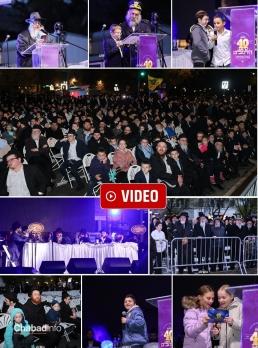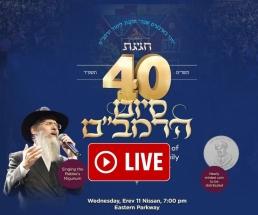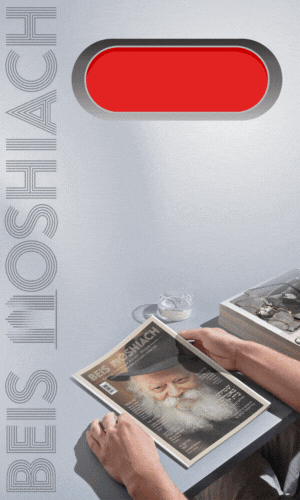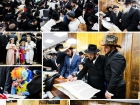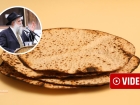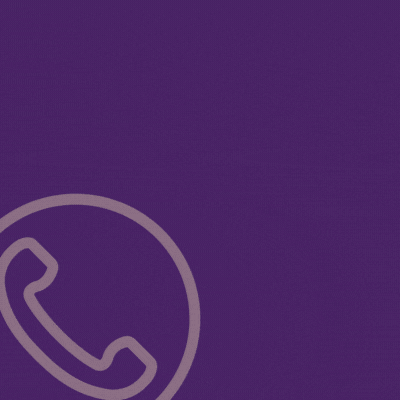“Not In My Worst Dreams…”
For three months, Mara D’asra and member of the Crown Heights Beis Din Rabbi Yosef Yeshaya Braun, was busy answering sha’alos on “Hilchos Pikuach Nefesh”… Now, baruch Hashem, he finally was able to sit down with us for an exclusive interview in which he related to us some of his thoughts and feelings about, undoubtedly his hardest moments as a Rov • By Beis Moshiach Magazine • Full Article
Avrohom Rainitz, Beis Moshiach
If you called the offices of the Badatz of Crown Heights recently, you heard the following unusual message, “Thank you for calling the Beis Din of Crown Heights. Unfortunately, the rabbanim are extremely busy now answering questions of pikuach nefesh mamash. Please try to find the answer to your question on the asktherav.com site which has answers to numerous questions.”
Indeed, the coronavirus that has shut down the world, greatly affected Crown Heights with dozens of people passing away and hundreds hospitalized. As in many communities around the world, the rabbanim of the community were involved in managing the tragedy. Here, unfortunately the questions were not only about closing the schools and mikvaos but often had to do with life and death matters.
Rabbi Yosef Yeshaya Braun, mara d’asra, put it well in one of his talks when he described the surreal situation in which rabbanim had to deal with questions of pikuach nefesh while simultaneously having to explain to people who just didn’t get it why holding minyanim was a problem.
“A woman calls me with halachic questions regarding her husband who is on a ventilator in the ICU of the corona department. The doctors were losing hope for his life. As we spoke, a call clicked in. I thought it might be another urgent call so I picked up to hear a yirei shomayim young man ask why the rabbanim had forbade a minyan in the street. As a result of such gatherings I’ve gotten questions of pikuach nefesh that I have to answer now on the other line!”
Despite his many involvements, Rabbi Braun agreed to be interviewed while keeping to the rules of social distancing and wearing a mask. He seemed a bit more relaxed since lately, the questions coming to the Beis Din reflect the turnaround. “Now, when men who were hospitalized for weeks are released from the hospital, the questions are whether they need to recite a full shehechiyanu blessing when their father comes home from the hospital.”
Two days before we spoke, the rabbanim issued a letter to the community in which they reported that due to the drastic decline in the number of sick people (thank G-d there were hardly any new cases in recent weeks and according to the doctors’ survey, most residents of the community have been exposed to the virus and have developed antibodies), they were handing over the reins to the doctors and government officials.
Until that letter was issued, the rabbanim dealt with every detail of the situation by way of letters to the community and whatsapp updates on nearly a daily basis. On the asktherav.com website, in addition to answers to the many halachic questions that came up there were nearly fifty taped messages that R’ Braun issued via a special whatsapp group that was set up for this purpose, which contained detailed instructions along with messages of support and encouragement.
One of the members of a chevra kaddisha in New York that dealt with an unprecedented number of burials, cited Crown Heights favorably for handling the crisis with united leadership and one Badatz. “In other religious communities, where there are various kehillos, there was no united leadership. Some rabbanim said to close the shuls while other rabbanim said to leave them open which caused a spike in the number of infections. Your mazal in Crown Heights is that all members of the Badatz were united and the residents of the community listened to them.”
In fact, despite a few lone voices who thought otherwise, people in Crown Heights saw that there is a united leadership and the three members of the Badatz established the conduct of the community and nobody else.
Unfortunately, the Badatz itself suffered a tragic loss of one of the rabbanim, Rabbi Aharon Yaakov Schwei, but the unity continued with Rabbi Avrohom Osdoba and Rabbi Braun leading the community with one voice. The rabbanim are in almost daily contact (via phone, of course) and every instruction to the public is issued after in-depth analysis carried out over the phone due to the current situation.
THIS IS HOW IT BEGAN
Although every community rav has to deal with questions of pikuach nefesh over the years, no rav ever trained for a medical emergency situation on the level of a pandemic. How did the involvement of the Beis Din evolve?
It all began on Friday morning, three days after Purim. There were three confirmed cases of corona in the local doctors’ offices and we were confronted by the harsh reality that China – is here. The doctors immediately called the Badatz and the principals of the schools to discuss how to respond.
We held a teleconference and after the doctors gave us the medical data that was known as of that point, I called the other two members of the Badatz, Rabbi Schwei and Rabbi Osdoba. Considering the available data regarding the degree of contagion and the great danger in the disease, we concluded that the schools must be closed immediately. As soon as the principals heard that all three rabbanim were behind this decision, they all fell in line with the directive. Within just one hour, all the schools were closed and students sent home. We then issued guidelines for those over 65 which said they should not attend shul.
Personally, I davened that first Shabbos at home and did not go to 770. Later, I also felt the symptoms and stayed home in accordance with the guidelines.
Afterward, I was told about older people who did not refrain from going to shul despite the danger. In the meantime, corona test results in Crown Heights began to flood in and we held another teleconference with the three members of the Badatz. We heard what the doctors and members of Hatzalah had to say, and they provided us with the painful facts. They told us of hundreds of calls in the previous days and the three of us came to the unavoidable conclusion that all the shuls and mikvaos must be closed, including 770.
CLOSING 770 SAVED THE LIVES OF MANY JEWS
The decision to close 770 shook up Chabad Chassidim worldwide. It was painful to see pictures of Beis Chayeinu closed. What were you thinking when you made this fateful decision?
Believe me, I did not dream that the day would come when I would issue orders to close 770. Then again, nor did I imagine a situation in which hundreds were hospitalized in critical condition with dozens who died. It definitely hurts to see 770 closed but, as Chassidim of the Rebbe who taught us how precious the body of every Jew is to Hashem, our hearts ought to shudder at the news of yet another Jew who has died of corona. This pandemic introduced us to a whole different world.
In one of the conferences with medical personnel, there were Chassidim who maintained that although there is a pandemic and the situation is bad, 770 should remain open because it’s the Rebbe’s shul and the Rebbe’s merit would protect those who davened there. We pointed out with some irony that they were exchanging roles with the rabbanim. Their job is to provide the medical data and the rabbanim should say what the halacha is. And the halacha is clear, when it comes to pikuach nefesh no weight is given to Chassidishe hergeshim, as lofty as they might be.
After the fact, closing 770 saved not only people in Crown Heights but also, to a great extent, many in other religious neighborhoods in New York, because when the leaders of those other communities heard that 770 had been closed, they were in shock. That is when they grasped the seriousness of the danger and said that the shuls in their own neighborhoods should be closed. There is no question that this step saved the lives of dozens, perhaps hundreds of Jews. In this context, we can suggest that Beis Chayeinu was the source of chaim/life for many Jews because it was closed!
The police also realized the tremendous impact in the rulings of the Badatz and before Pesach they asked us to issue a letter about not opening the shuls on Pesach. We said that we had already written that in earlier letters and there were instructions from the doctors and government instructions, but the police insisted that we write not to congregate in shuls on Yom Tov. They said with obvious respect that they see the impact of the Badatz on the community.
Indeed, although there were respected Chassidim in the community who did not understand the scope of the epidemic and said the shuls should remain open, the community as a whole was united behind the decisions of the rabbanim. We saw the power of achdus that when the rabbanim are united, the instructions of the Badatz are far more impactful.
As I mentioned, many people had a hard time understanding why all minyanim should be closed. I must point out that from a halachic standpoint, it was much more difficult to accept the decision to close the schools than to close the shuls. Tefilla b’tzibbur is a rabbinic mitzva and does not have the full status of an absolute obligation, while Torah study of the many has a status close to pikuach nefesh. It’s not at all simple.
That’s all before getting into the topic of the internet which became far more widespread as a result of the schools being closed and children learning remotely. Although we must be careful and use filters, there is a still a great danger both materially and spiritually.
The Badatz then clarified that the guidance included home minyanim. In Eretz Yisrael, despite the shuls being closed, they were allowed to daven in open spaces. Why was this forbidden in Crown Heights?
As everyone knows, the situation in Crown Heights was many times worse than in Eretz Yisrael. There were days with three-four funerals. We decided to be so strict for several reasons, mainly because: 1) although most participants in these minyanim kept their distance, there were plenty who did not and they endangered everyone else, and 2) many older Chassidim would not refrain from attending these minyanim when they knew that there was a minyan a few feet from their house. The only way to prevent them from davening in a minyan, thus saving their lives, was by forbidding any minyanim. I have no doubt that this decision saved the lives of many people.
INTERESTING HALACHIC INSIGHTS
While doing shimush for rabbanus, rabbanim do not learn how to deal with corona epidemics. Although there is a prodigious amount of Torah literature from gedolei Yisrael about dealing with epidemics, no rav learns the dinim. Until a few months ago, these dinim seemed pertinent to the distant past. But history repeats itself and the rabbanim had to start looking through these halachos in order to find a basis for contemporary rulings pertaining to corona. At Machon Yerushalayim, within a few weeks they had published a new volume in the series Neemnu Me’od, a thick volume that has 300 dense pages on the topic of epidemics and the halachic ramifications.
You have had to pasken halachos on rare subjects. What interesting halachic sources did you find?
First, there are the basic halachos of pikuach nefesh. However, as soon as corona began, they began publicizing the pesakim of Rabbi Akiva Eiger to his community during an epidemic and many other piskei dinim from Rishonim and Acharonim. Rabbi Akiva Eiger forbade public gatherings, limited minyanim to fifteen people and even asked the police to stand guard. He also ruled that whoever davens with a minyan on Rosh Hashana should not go to shul on Yom Kippur and the other way round too. Obviously, it is not all the same and some of the psakim were based on medical information that is very different than that of today, but for the most part the nature of such epidemics is the same.
In addition to the halachic literature that deals directly with epidemics, it was interesting to see how it is possible to derive practical guidance from all parts of Torah, “turn it and turn it for everything is contained within it.” For example, many people were upset that shuls were closed while grocery stores were open. Aside from the fact that buying food is essential and without being able to buy food people will reach a state of pikuach nefesh, there is a big difference in the potential for spreading the virus between groceries and shuls, even though both are closed areas.
First, you spend a long time in shul and most people spend a short time in a grocery store. Second, in shul there is a large crowd which is unlike what you have in a grocery. Third, in a shul you daven out loud which increases the spread of the virus (there was a choir where one member tested positive and it turned out that all the choir members caught it. Research showed that the anomalous outcome of 100% contagion occurred as a result of the increased dispersion of the virus due to the raised voices). In groceries people don’t speak much and they definitely don’t break out into pieces of chazzanus …
Above all else, the reality is that most owners of groceries are particular about not allowing in crowds and do not allow people to enter without a mask. They don’t make the effort out of the goodness of their hearts; they know that if inspectors come around and discover that the rules are being broken that they will be fined. As opposed to shuls where we saw some people who thought they were smart and opened the shuls even when it was illegal because of the seriousness of the situation, and found legal loopholes that enabled them to do so. Many people davened there and who knows how many people lost their lives as a result.
The most interesting difference between groceries and shuls is something I found in the halachos of dipping maror in charoses! In the sefer Leket Yosher, written by the talmid of the Terumas Ha’Deshen, about whom the Rebbe said that his writing [about the customs, practices and rulings of his rebbi] is like the writing of a Chassid about his Rebbe, he writes that when you light the Chanuka menora in the house of a non-Jew, you light one candle only lest “once in a hundred times” a fire will break out and lead to danger to life, and this will reflect badly on the mitzva. And for this reason, not to cause denigration of the mitzvos, we are worried about even a far-out concern.
He bases what he says on the saying of the Gemara that the reason we dip the maror in charoses is because sometimes there are toxins in the maror and the charoses neutralizes the toxin (Rashi in Pesachim 116). He asks, why then, do we eat lettuce without charoses all year round? He explains (and there is a source for this in the writings of other Rishonim) that this concern is specific to the seder night since it is a mitzva and we need to be extra careful not to endanger ourselves when eating the mitzva food, so that it not reflect negatively on the mitzva.
From this we learn for our times that when it comes to a mitzva to be more careful than in optional matters lest it lead to a denigration of the mitzva!
On a related matter, in Mekor Chaim written by the Chavos Yair, it says that it is proper for one who davens b’yechidus to daven together with his son and with the tune that the shul uses. Also publicized was a tradition of Chassidim that when there is no minyan to try and daven with three men and I also found some halachic sources that pasken that there is a status of a “rabbim” for three and even two and therefore, even when davening at home, to try and daven with another member of the household.
We also cited sources in connection with “emissaries for a mitzva are not harmed” which applies only when “harm is not prevalent” and also, only when talking about harm to oneself, while with corona it also harms others. We also brought sources in connection with the percentages of danger to life that halacha considers. I had to argue with someone who was upset that the schools, shuls and mikvaos, were closed who asked why isn’t getting into a car forbidden considering all the road accidents? Actually [Rabbi Braun said smiling], if I could, I might forbid that too … but the difference is enormous. How many people in Crown Heights died in a car accident this past year and how many died of corona within a few weeks? These are facts that can’t be disputed.
We also emphasized how important it is not to cause harm to others and that it entails d’Oraysa prohibitions of “do not stand by your brother’s blood” as well as the positive Torah obligation to take care of your health.
Obviously, as Chassidim, we tried to derive from the teachings of our Rebbeim, especially from the Rebbe (where there is a lot about to what extent Chassidim are careful about not harming others, even with a far-fetched concern) about the right Chassidic outlook on these situations. For example, I quoted what the Rebbe said to those Chassidim who did not want to carry out medical directives, and even did their own medical research. The Rebbe told them to obey the doctors and as far as their thoughts, to divert their minds from it entirely and only think positively.
In general, much was said about the Rebbe’s instruction to think positively, as per the command of our Rebbeim that when thinking positively, it positively affects reality, etc.
By the way, I must note how special the people of this community are, as the tragedy that we lived through also served as a window into the worlds of their deep inner lives. I was amazed by the pure faith and the tremendous bitachon in Hashem that the families of those sick with corona displayed in the face of the bleak prognostications of the top doctors. They maintained their bitachon and it amazed me time and time again.
This is aside from the tremendous chesed on the part of the people of Crown Heights, whether at the peak of the disease, helping the sick and their families and then later, setting up a rehab center at the cost of tens of thousands of dollars. It’s an unbelievable chesed!
A TREMENDOUS LOSS
Amidst all the suffering in the community where there was barely a block without some loss, the members of the Badatz suffered a catastrophic loss with the passing of the mara d’asra, Rabbi Aharon Yaakov Schwei. In recent years he had been in critical condition and was actually a living miracle, and then he also contracted corona. Although he miraculously overcame corona and had begun to recover, he fell prey to another condition and his weakened body did not withstand it and he passed away.
His passing shocked the community and particularly the Badatz. In such difficult times, when the community needs strong, united leadership from the Badatz, the loss is all the greater. Although the two remaining members of the Badatz continue to lead the community together, the vacuum left by the passing of Rabbi Schwei is great.
In the words of Rabbi Braun, “Rabbi Schwei was a bridge between generations. He connected the generation of the elder Chassidim from Russia and Samarkand with the new generation that arose in America. He broke through all barriers and conveyed the pure Chassidic truth with the language of the heart, which he knew so well. He was able to reach everyone through the heart.
“They say that if there is truth there is no peace and if there is peace there is no truth, but Rabbi Schwei was able to unite opposites. He embodied truth in its purity, believed with complete faith in every word of the Torah and every word of the Rebbe. The prophecy of the Geula and the Besuras Ha’Geula were holy of holies to him and he lived with complete faith that no word of the Rebbe would fall short. He was a real leader and at the same time, a man of peace; between man and his fellow, between man and wife, in every area, in every situation.
“His passing is a tremendous loss for us all. As Chassidim though, we know that we cannot stop. With all the pain we need to move forward. As the Rebbe taught us after the passing of the Rebbetzin, we need to channel all the pain into action and “the living will take it to heart.” The Rebbe took that verse and turned it into a slogan, into a way of life.
“Therefore, the passing of the rav is a wake-up call for us all, a call to action in two main areas: 1) Ahavas and Achdus Yisrael. We will continue in Rabbi Schwei’s footsteps and lead the community in unity and full collaboration. 2) We will continue in Rabbi Schwei’s footsteps in spreading the Besuras Ha’Geula with pure faith in every word of the Rebbe, all on the basis of Chassidishe hiskashrus.”
Can you share some insights with us that you saw from Rabbi Schwei while working with him?
Obviously, I cannot tell personal things but in general terms I can say that what people saw in Rabbi Schwei when they met with him, I had the privilege of seeing every day. Aside from his ge’onus and bekius and his broad view of community matters, I saw his near-angelic dealings with people in the community.
His patience was superhuman. There are people with patience, but there are those who drive even the most patient person crazy. Rabbi Schwei managed to be patient even with the toughest people. The average person could not put up with it.
His consideration for others was amazing. One small example from personal experience – in recent years he found walking difficult and he needed a ride from the offices of the Badatz to his home. His son, R’ Mordechai, would come every night to take him. Rabbi Schwei never left the office without first asking whether I was also ready to go and then of course he offered a ride. He always told his son to drop me off first and then to take him home. Sometimes, I felt uncomfortable by his putting himself out for me but he would not concede.
As far as his health, recently it was very hard for him to go up steps. One flight of stairs took him many minutes to climb and then he had to rest for several minutes before he could continue with his work. People sometimes stopped him on the stairs to ask him questions. He had a hard time breathing but he made the questioner feel good and mustered all his strength to respond to the question.
In his great humility he was unwilling for us to install a contraption, similar to an elevator, to save him the difficult climb to the Badatz office. It was only after we told him that someone donated money exclusively for this that he agreed. He only got to use it for a few days because then he became sick.
Much is said about his greatness in Torah but over the years, I also found out about his greatness in avoda, avodas ha’tefilla in particular and avodas Hashem in general. He told me that the Rebbe told him to daven at length and how, when from all the time he put into davening he found it hard to daven mussaf after he had used up all of his physical strength, the Rebbe told him to make kiddush before mussaf and eat some mezonos so he would have the strength to continue davening at length.
As far as Moshiach, it was known how strong was his faith in the fulfillment of all the Rebbe’s prophecies and he greatly yearned for the hisgalus of the Rebbe Melech Ha’Moshiach.
TAKING HOME THE MESSAGES
Talking about Moshiach and Geula stirred up memories of the tremendous inspiration during Nissan and the night of the seder and Acharon shel Pesach especially. Around the world there was the feeling that this Pesach would not end with us in galus; we would all fly on clouds to Eretz Yisrael. And here we are, in Sivan, and unfortunately, we don’t yet have the complete Geula.
Many ask, how is it that after such a great awakening that the Rebbe still did not come with the complete Geula?
A spiritual awakening, as great as it might be, does not last and does not have an effect if it is not translated into action. The Rebbe, in the Igros Kodesh, applies the verse “clouds and wind and there is no rain (geshem)” to this – you can go very high but if you don’t bring things down into gashmiyus, into concrete action, nothing remains of it.
That is how Chassidim would interpret the prayer, “Who chooses shirei zimra (lit. songs of praise),” that Hashem chooses the shirayim (leftovers) of farbrengens, i.e. the practical actions that result. Indeed, at the Rebbe’s farbrengens you could see how even though the Rebbe spoke about lofty matters, he always brought it all down to action, as the Rebbe would say, “action is the main thing.”
If this is always so, all the more so is it true when speaking about bringing the Geula which is a fundamental change in the physicality of the world and the transformation of the world of galus into a a world of Geula. A one-time inspiration is not enough; we need inner work that comes from a place of contemplation and study.
We had a great illumination from above but now we need to translate it into action. Now, as we begin to return to routine, people are losing the passion of emuna that they had just a month ago, as the Rebbe Rayatz put it about Americans, that they are like straw. They ignite quickly but also fizzle out quickly.
The Rebbe’s aphorism in the HaYom Yom for Isru Chag is most fitting, that on Pesach there is the revelation of Moshiach but afterward, we encounter the matters of this world. The kuntz is to take the revelation of Moshiach and internalize it in order to draw it down afterward into the matters of this world.
What do you suggest to make this happen?
The direct way, not only to bring the Geula but to also live inyanei Geula with a pnimiyus, is by learning inyanei Moshiach and Geula as the Rebbe said at length. This includes inner contemplation of inyanei Geula as the Rebbe said, “That he connects his mind with a strong and mighty bond and fixes his thoughts strongly in inyanei Moshiach and Geula.” Meditating on the subject in a way of daas will bring about a transformation in all aspects of life, especially in bringing the subject into a pnimiyus.
This is how Chassidim interpreted the verse, “Do not say what used to be was better than this because it is not with wisdom that you asked about this” – do not say that once, in the early days, I was a Chassid and I was inspired, because that inspiration wasn’t derived from your great wisdom, but rather it was loaned (the Hebrew root sha’al means both ask and lend) to you so you could have the good sense to use it and internalize it by learning and taking action. But when you don’t utilize an auspicious time then you need to return what you borrowed and you are left with nothing.
There is the parable of the rich man who called over two men and gave them a lot of money to invest and earn money. One went and invested and the other squandered the money. At the end of a year, he called for them and to the man who invested he said: keep it because you knew how to use it. To the one who squandered the money he said, it was a loan and now you need to return it, down to the last penny.
There are no shortcuts. These days, we need to use the remaining inspiration of the corona days and add in learning about Geula in general and the Rebbe’s Besura Ha’Geula in particular and also to add in practical action, with added hiddur in Torah and mitzvos.
When we do our part, surely Hashem will do His and even before we reopen 770 to all, the Beis Rabeinu sh’b’Bavel along with all the other shuls in the world will go to Eretz Yisrael and be established in the third Beis HaMikdash; and even before we open the yeshivos and schools, it will be Yemos HaMoshiach and we will learn Torah Chadasha from the Rebbe Melech HaMoshiach himself, teikef u’miyad mamosh!
*
The magazine can be obtained in stores around Crown Heights. To purchase a subscription, please go to: bmoshiach.org
565
Join ChabadInfo's News Roundup and alerts for the HOTTEST Chabad news and updates!















